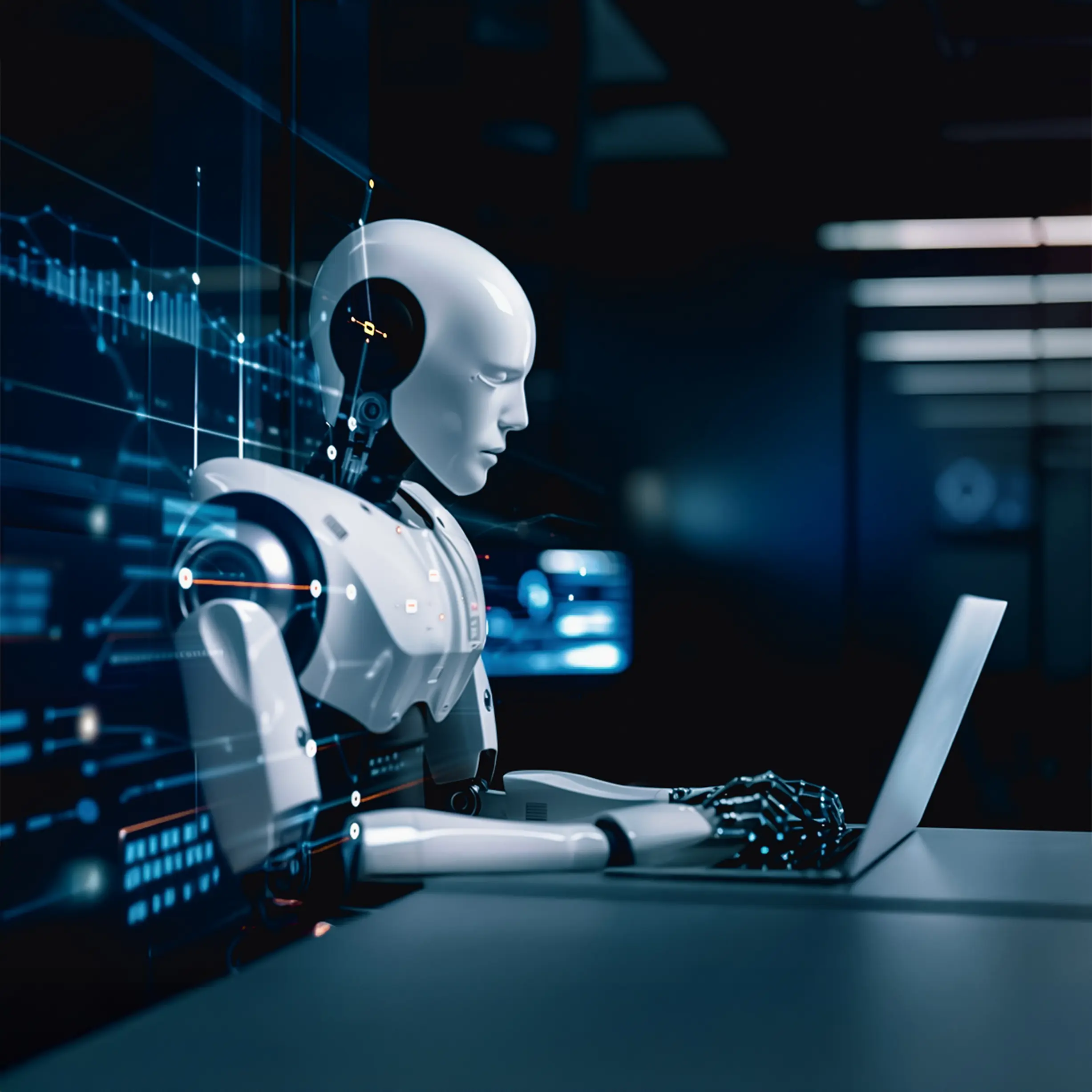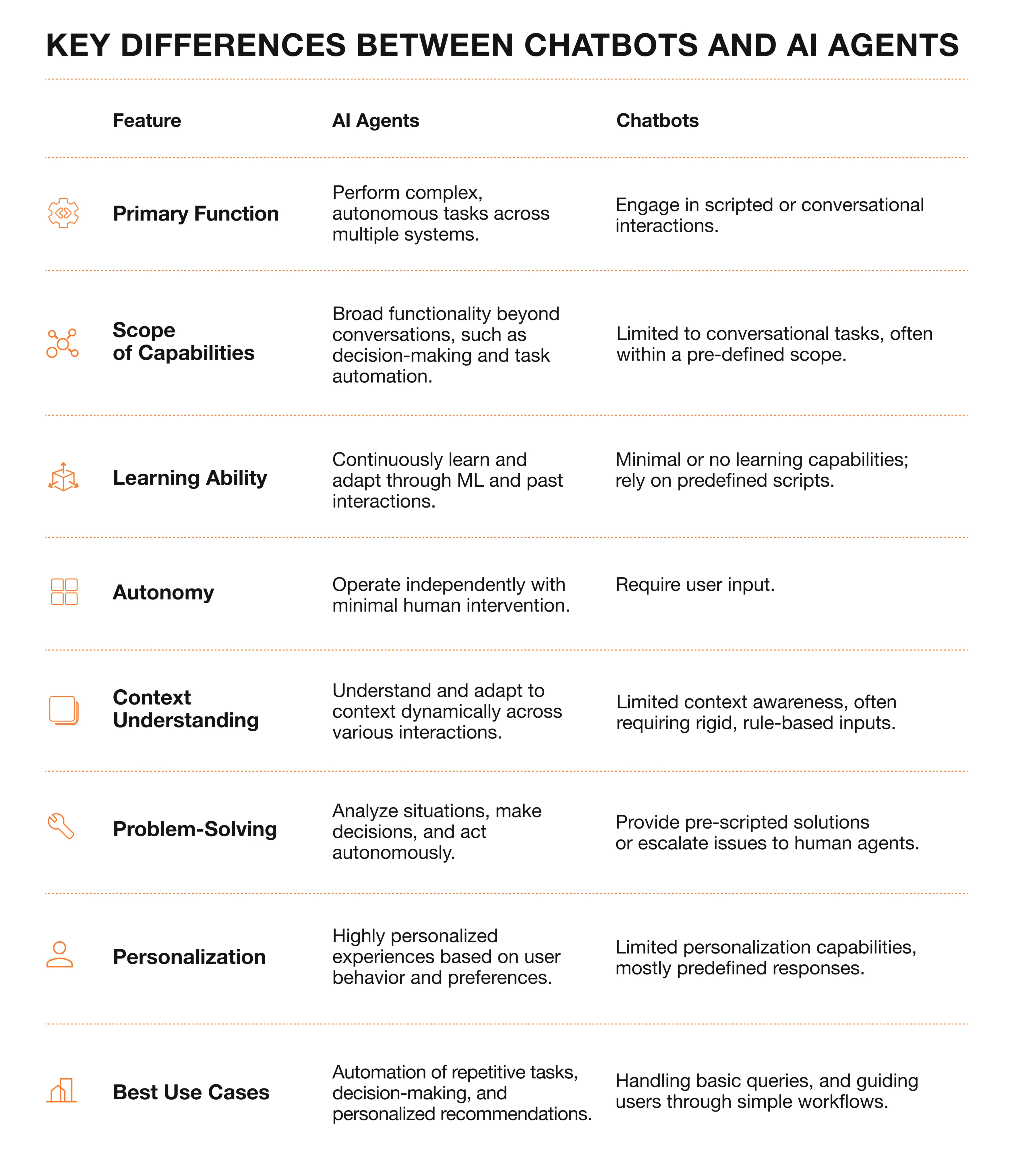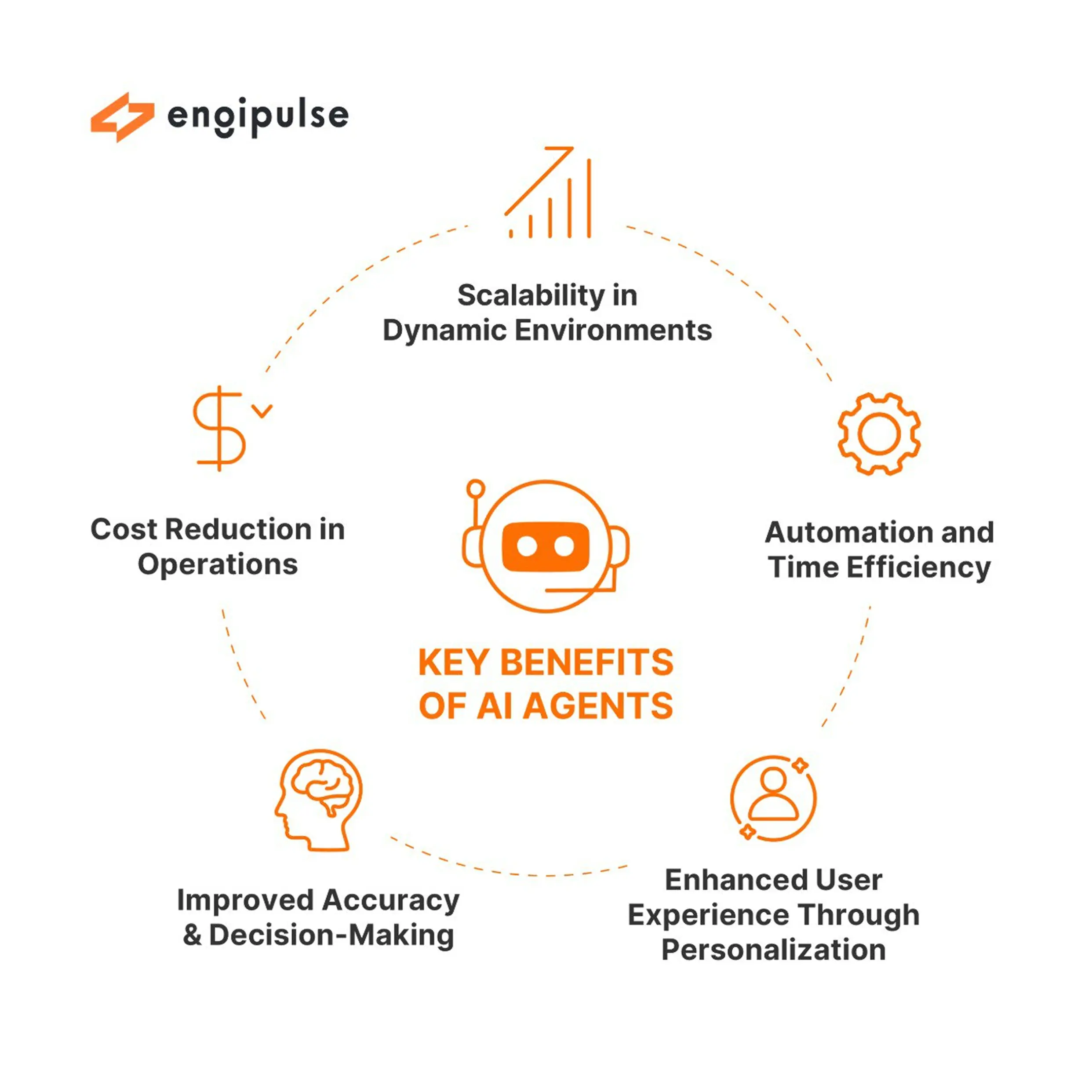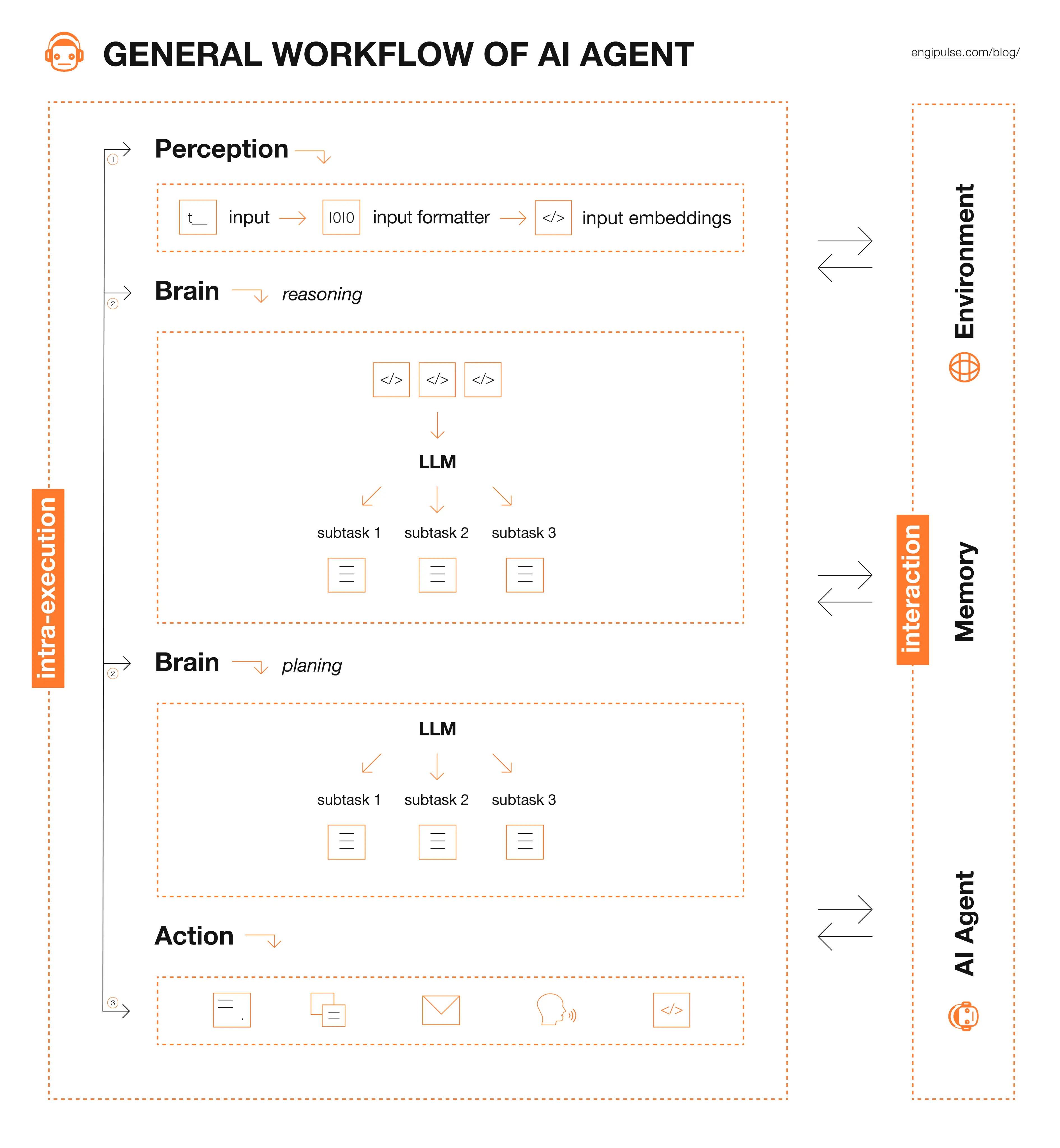Agentic AI 2025: Types, Use Cases, Industries, and More
Other
26/05/25
Read time: 19 min
The tech world has widely adopted artificial intelligence for the last several years, whether AI-powered chatbots, generative AI like GPT models, or computer vision systems. Data shows that between 2022 and 2030, the AI market is growing at a CAGR of 37.3%. Everything indicates that this is only the beginning. As consumer demands are evolving, so is the need for more advanced AI systems, the ones that can get the jobs done for us (particularly those capable of handling mundane and time-consuming tasks). This is where AI agents come into play. These sophisticated companions automate tasks across multiple industries, from high-tech to e-commerce and Fintech.
Without the need for human intervention, these autonomous minds can consolidate data across multiple data sources, analyze it, and make conclusions, control smart home devices, help buyers make real-estate purchasing decisions, schedule meetings, and so much more! Sounds promising? Buckle up, and let’s begin exploring the agentic AI phenomenon together.
What Are AI Agents

First things first, let’s begin with a definition. According to IBM, an AI agent is a software or system that can define its workflow and use the tools at its disposal to carry out tasks on behalf of a user or another system. Unlike traditional language processing models, these agents have a far bigger functionality, including decision-making and problem-solving. Plus, they can interact with external environments to gather data and execute tasks autonomously based on real-time inputs. Sounds super promising, right? You’re certainly not the only one thinking this way. The use of AI agents in organizations is increasing; according to Deloitte’s Global 2025 Predictions Report, 25% of generative AI-using enterprises plan to implement AI agents in 2025, with that number expected to rise to 50% by 2027. Companies’ desire to automate non-essential tasks is the main driver of this expanding interest; Salesforce admits that they spend 71% of their time on non-selling tasks, such as administrative work and manual data entry.
The cloud CRM giant’s drive to enhance automation is likely a key factor behind its decision to launch AgentForce 2.0 in February 2025. This revolutionary tool is designed to take the load off multiple teams’ shoulders, primarily:
- customer service;
- sales;
- marketing;
- executive & strategy;
- and even development teams.
The functionality is extensive: AgentForce 2.0 will be able to script emails and potential responses to help with lead nurturing; increase marketing campaign response rates; assign tasks to responsible team members; generate targeted messages to increase personalization, and even write code. Plus, users will be able to easily create new agents with the Agent Builder functionality using natural language descriptions. This release is a prime example of changing consumer expectations. Telling people what to do is no longer enough for an AI to be considered useful — it needs to handle the mundane and repetitive tasks for us, freeing us to focus on strategic and creative responsibilities.Read also: The Ultimate Guide to Building Your Dedicated Development Team
Key Characteristics of AI Agents
All types of AI agents have a bunch of common characteristics that differentiate them from other AI tools. These are:
- Autonomy. AI agents function autonomously, making decisions without constant human supervision. By analyzing their surroundings, they carry out tasks based on preset objectives or taught habits, minimizing the need for human input.
- Perception. AI agents are equipped with sensors, APIs, or continuous data streams that gather information in real-time to understand their surroundings. For example, an autonomous car equipped with cameras, LIDAR, and GPS can identify road and traffic conditions to make safe driving decisions.
- Reasoning. AI agents can use logical frameworks and data analysis to choose the most effective course of action.
- Learning. AI agents gradually adapt and get better through machine learning techniques. They pick up knowledge from feedback loops, user interactions, and prior experiences.
- Action. AI agents take action in addition to analyzing and learning. An e-commerce application’s recommendation engine, for example, forecasts consumer preferences and instantly modifies product recommendations, improving the user experience.
What Is the Difference Between an AI Agent and a Chatbot?
Although terms like “Gen AI”, “AI-powered chatbot”, “AI agent”, “Language model” and multiple others are often used interchangeably, there’s a significant difference between them. For now, let’s focus on debunking myths about the first two.
Unlike AI agents, chatbots have limited functionality. In customer service, for example, they’re responding to user requests based on predefined scripts. If a chatbot is asked a question outside of its knowledge base, it redirects the customer to human support.
Let’s consider a common customer support issue: a customer wants to know the status of their late order. In this case, a chatbot typically asks the customer for the order ID, retrieves the basic shipping information, and responds with a prescription message like “We’re sorry, your order has been delayed. Please check back later for updates.” or “How else may I help you?”. While such a course of action may have been acceptable a few years ago, it is both inefficient and restrictive in 2025, when a customer experience can make or break your business.
An AI agent acts differently. It automatically recognizes the client and retrieves their order history: “Hello! You’ve recently placed an order for [product name]. I’ll check the order status for you”. After identifying the reason behind the delay, the AI agent provides the customer with practical ways to address the problem, such as: “Your delivery has been delayed due to [reason]. I’ve already requested expedited shipping at no extra cost, and your package will arrive by [new date].” It then offers to add a similar product to the customer’s cart by using its recommendation engine to suggest items that are available for immediate delivery. The result? The customer felt valued and heard, their issue was promptly resolved, and they’d like to order again and even recommend the brand to their family and friends. Considering that 80% of customers will switch to a competitor after one bad experience, such a smart AI agent seems like a lucrative investment.

Types of AI Agents
There are various types of AI agents, ranging from the simplest to the most advanced. Depending on your organization’s needs, budget, and scope of work, you can choose from the following options:
Simple Reflex Agents. This type of agent is the simplest one, and can only operate if it has access to all the required information. It can’t interact with other agents and doesn’t have any memory. In cases when it encounters an issue it is not prepared for, it can’t respond or take action. A motion-sensor light is one example of a simple reflex agent. It is activated or deactivated by a single, precise input. Beyond its predetermined triggers, it can’t learn to adjust to more complicated circumstances, including whether it is an inanimate object or a person, or responds to environmental changes.
Model-Based Reflex Agents. This type is more advanced than simple-reflex agents. It has a memory that updates once the agent receives more information. However, unlike more advanced types, it still can’t act in scenarios outside the predetermined sets of rules. A robot vacuum cleaner keeps your house in memory to avoid obstacles and avoid entering areas it has already cleaned.
Goal-Based Agents. To make decisions and act, goal-based agents use reasoning guided by predetermined objectives. They assess both the present situation and potential actions needed to get the job done, plan, and act accordingly. A navigation system that analyzes traffic and time towards a destination is a goal-based agent. If the agent’s condition-action rule states that one route is faster, the agent recommends it over the other one.
Utility-Based Agents. This type is essentially a more progressive goal-based agent. A so-called “utility function” gives each scenario a utility value, a metric that quantifies the usefulness of an action or how “happy” it will make the agent. Based on the information received, the agent then chooses the most efficient scenario and provides recommendations accordingly. For example, a self-driving car doesn’t just get you places; it analyzes various conditions like battery life, weather conditions, and maximum passenger comfort to reach the destination as efficiently as possible.
Learning Agents. These smart companions combine the characteristics of all the above, plus they can learn and adapt based on feedback. They are brilliant in their capability to improve decision-making based on new experiences and produce a better outcome in the future. These agents are often used in retail. Thanks to their ability to learn based on customer actions like specific product interests, purchasing habits, and frequency and cart abandonment, it can learn to provide targeted recommendations. Just imagine, you’ve skimmed through the ski apparel brand for some time, and once you visit it again, it surprises you with a targeted banner based on your preferences. It can also provide you with personalized discounts, recommend items to “finish your look” or remind you when it’s time to replace gear you’ve bought previously. The more you visit the website, the better the agent’s recommendation becomes.
Key Benefits of AI Agents
As we’ve already mentioned, the application of AI agents is quite universal — they can substantially improve automation across various industries and departments.
Automation and Time Efficiency
Once you make a strategic decision to employ an AI agent, you’ll see that your employees have free time to focus on more high-value tasks. Having an agent that analyzes available time slots by going through teams’ calendars or automatically assigning tasks to team members with the best suitable expertise can help project managers better plan and take actions to improve performance. Data shows that 90% of employees are burdened with monotonous chores that could be automated. The full potential of your talent can only be unleashed if you provide them with meaningful work.
Improved Accuracy and Decision-Making
52% of businesses notice a reduction in manual errors due to automation. And it’s not surprising, considering that AI agents analyze vast amounts of data, constantly improving their reasoning. They don’t get tired, can’t be distracted, and only operate within limited environments, making them the most hardworking experts who thrive on consistency and precision in their designated tasks.
Cost Reduction in Operations
The same research indicates that 31% of businesses see decreased labor costs due to automation. Based on our experience, choosing to employ an AI agent decreases the need for extensive human resources, meaning you can work with top-notch professionals covering only the most sophisticated and complex tasks.
Enhanced User Experience Through Personalization
We’ve already mentioned how a single AI agent can improve consumer satisfaction. The formula is simple: once your customers feel valued, and cherished, get personalized suggestions and timely issue resolution that goes beyond simple responses — you get loyal brand fans who want to come for more.
Scalability in Dynamic Environments
One of the best things about AI agents is that they can seamlessly adapt to changing demands. If your organization is undergoing growth or you’re worried that agents won’t be able to operate effectively once you scale — don’t worry! These agents are designed to handle increased workloads, integrate with new systems, and optimize their processes in real time. A lot of AI agents use cloud platforms, which gives them on-demand access to scalable processing power and storage. Plus, since they easily integrate with new platforms, devices, and APIs, you don’t have to worry about them not working when you adopt new tools and expand operations. Finally, they learn. No matter how much data you feed them — they’ll be able to make accurate decisions even as the complexity of tasks increases.

Applications of AI Agents Across Industries
AI agents have one bonus benefit: they are universal. Their dynamic reasoning and extensive capabilities can improve operations in multiple industries: healthcare, Fintech, media, entertainment, automotive, e-commerce — you name it! But for now, let’s focus on five industries that benefit from the magic behind these intelligent systems.
High-Tech
AI agents are revolutionizing semiconductor manufacturing. They find the optimal combinations and automate complex processes. Large datasets are analyzed to improve chip performance and layouts while using the least amount of power possible. AI-driven solutions, including Synopsys DSO.ai and Cadence Cerebrus, optimize chip design processes and shorten time-to-market. Block engineers define the design objectives, and Cadence Cerebrus’s generative AI agent automatically and intelligently optimizes the design to achieve power, performance, and area (PPA) objectives. The agent’s full-flow reinforcement learning potential and LLM capabilities help improve engineering teams’ capabilities so that they can quickly optimize flows for many blocks simultaneously, thus using that knowledge for the next design.
Retail & E-commerce
Application of AI agents in this industry is almost inconceivable: from personalized product recommendations and inventory management to sentiment analysis and virtual try-ons, this technology is changing the way people shop. One primary example is Merchant, Buyer, and Personal Shopper retail agents by Salesforce. These agents perform tasks like product recommendations and order lookups independently, reducing the need for human intervention. For example, in order to provide customers with a customized shopping experience, a Personal Shopper assistant suggests fashionable or complementing items based on their past purchases.
A Buyer agent simplifies order management by tracking shipments or recommending reorders for popular items, while a Merchant agent identifies underperforming products and recommends pricing strategies. Beyond front-end improvements, these agents go as far as optimizing back-end operations. Merchant agents monitor inventory and suggest restocking strategies based on demand, while Buyer agents analyze supplier information to find the most cost-efficient opportunities. The results are incredible — businesses improve both operational efficiency and profit margins.
Finance & Banking
Leveraging Engipulse insights, finance and banking might be two industries with the most diverse use of AI agents. One most common use case is fraud detection and prevention. These smart helpers flag unusual credit spending behavior in a matter of seconds, ensuring your funds are safe and sound. A virtual financial advisor offers advice on savings programs or recommends an investment portfolio that is customized based on a client’s financial history and risk tolerance. In order to arrive at a more accurate assessment of risk, they can also examine the creditworthiness of loan applicants by taking into account variables including payment history, employment stability, and spending patterns. AI agents are even used by hedge funds to track market patterns, forecast price changes, and maximize profits on portfolios.
Automotive & Aviation
Finally, AI agents enable predictive maintenance for automobiles, improve traffic flow, and power autonomous driving systems. In aviation, they help with flight route optimization, real-time aircraft system monitoring, and simplifying passenger services like ticketing and tailored recommendations.
How It Works: Example of a Simple Agent for Task Automation
To understand how an AI agent works, let’s consider the example of a task automation agent used for scheduling meetings based on user requests.
- Input (Perception):
The user provides input, something like, “Schedule a meeting with Team A for next Friday at 3 PM.” The agent picks up the request and changes it into a machine-readable format or input embeddings.
- Processing (Reasoning):
This format is then passed to the LLM, which decomposes the task into sub-tasks. The sub-tasks identified by the LLM will include checking the participants’ calendars, finding a time slot, and sending out invitations.
- Planning:
Now, the agent makes a plan on how to process the subtasks in the right order. It may check availability first, then select a proper time, and finally draft and send out meeting invitations.
- Execution (Action):
It executes them by calling external utilities or systems such as the company’s calendar or email system. Finally, it sends notifications about the scheduled meeting to all participants.
- Feedback Loop:
In case of conflicts, say a participant is not available, the agent will revise its planning and can ask for further clarification from the user to complete the task.

The Future of AI Agents Approaches Now
The upcoming years will not just be about AI Agents. We may see networks and swarms of agents working together, or even competing with one other, said Sequoia Capital partner Konstantine Buhler. This is very likely, especially in light of the upcoming release of AgentForce 2.0 and its ground-breaking features that will allow even non-technical users to create many agents for different tasks. Ultimately, agentic AI focuses on completing tasks rather than merely instructing people on how to perform them.
If you are interested to learn more about Agentic AI or want to develop one for your business, contact Engipulse, your trusted partner in efficient software engineering and AI teams.




